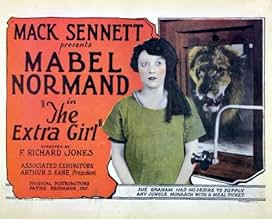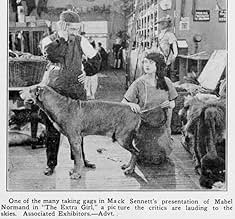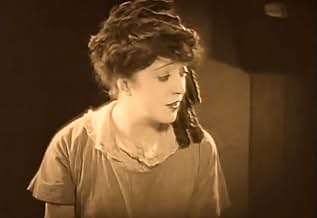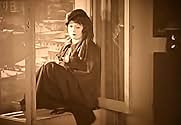IMDb RATING
6.7/10
1.2K
YOUR RATING
A small town girl dreams of movie stardom. A switched photo wins her a movie contract. However, when she arrives Hollywood, she is assigned to the props department. Her parents visit and inv... Read allA small town girl dreams of movie stardom. A switched photo wins her a movie contract. However, when she arrives Hollywood, she is assigned to the props department. Her parents visit and invest some money with a very shifty individual.A small town girl dreams of movie stardom. A switched photo wins her a movie contract. However, when she arrives Hollywood, she is assigned to the props department. Her parents visit and invest some money with a very shifty individual.
- Director
- Writers
- Stars
Anna Dodge
- Ma Graham
- (as Anna Hernandez)
George Beranger
- Actor in Wardrobe Line
- (as Andre Beranger)
Billy Armstrong
- Comedian in Derby
- (uncredited)
- Director
- Writers
- All cast & crew
- Production, box office & more at IMDbPro
Featured reviews
Somewhere between the Rocky Mountains and Pittsburg, spunky Mabel Normand (as Sue Graham) lives in a small town. She longs to be a movie actress. When her parents arrange for Ms. Normand to wed rotund Vernon Dent (as Aaron Applejohn) instead of handsome childhood sweetheart Ralph Graves (as David "Dave" Giddings), the spirited young woman decides to leave town. Normand first agrees to elope with Mr. Graves, but she is unable to leave her loving parents. She finally exits her small Illinois town, after winning an invitation to Hollywood from the Mack Sennett studios (as the Golden State Film Company). Appropriately, her departure is in Mr. Sennett's comic style. In Hollywood, Normand is not welcomed as a potential star. The photo she sent was switched with a beautiful young star, by a rival for Graves' attentions. Instead, the studio gives the teary-eyed Normand a job in their wardrobe department...
"The Extra Girl" is not a confident feature-length story, mixing styles with inconsistent success. Although the title presumes Normand becomes an "extra" on her way to becoming a movie star, it never happens. In the film's comic highlight, she does manage a screen test. Norman also takes a lion for a walk around the studio lot, thinking he's "Teddy" the Great Dane. The former canine superstar has a subdued cameo. An obviously villainous Ramsey Wallace (as T. Phillip Hackett) swindles Normand's pitiful parents George Nichols and Anna Hernandez (as Pa and Ma Graham) out of a small fortune and Graves joins them to steal the picture. Normand and Sennett parted after this film and she attempted one more feature before returning to shorts, the genre which made her a popular teenage star. Formerly considered to be one of the screen's finest comediennes, Normand was beset by personal problems and never regained her footing.
****** The Extra Girl (10/28/23) F. Richard Jones ~ Mabel Normand, Ralph Graves, George Nichols, Ramsey Wallace
"The Extra Girl" is not a confident feature-length story, mixing styles with inconsistent success. Although the title presumes Normand becomes an "extra" on her way to becoming a movie star, it never happens. In the film's comic highlight, she does manage a screen test. Norman also takes a lion for a walk around the studio lot, thinking he's "Teddy" the Great Dane. The former canine superstar has a subdued cameo. An obviously villainous Ramsey Wallace (as T. Phillip Hackett) swindles Normand's pitiful parents George Nichols and Anna Hernandez (as Pa and Ma Graham) out of a small fortune and Graves joins them to steal the picture. Normand and Sennett parted after this film and she attempted one more feature before returning to shorts, the genre which made her a popular teenage star. Formerly considered to be one of the screen's finest comediennes, Normand was beset by personal problems and never regained her footing.
****** The Extra Girl (10/28/23) F. Richard Jones ~ Mabel Normand, Ralph Graves, George Nichols, Ramsey Wallace
Country girl Mabel Normand travels to Hollywood in the hope of becoming a movie star after winning a competition, without realising that her love rival for the boy-next-door, Ralph Graves, substituted a glamour photo for her own, so she ends up working in the costume department. Normand's health problems were finally beginning to take their toll when she made this pleasant but unremarkable comedy, and the William Desmond Taylor affair had irreparably damaged her career, but she still makes a winning heroine. Highlights include her disastrous audition and a lion on the loose in the studio.
This is not the usual Keystone comedy that we associate with Miss Normand. However, it should be understood that no 'Madcap Mabel' pictures had been produced since 1916, and the last of these contained little slapstick. The post-Goldwyn Sennett films are a build up to Extra Girl, which may be seen as the culmination of Mabel's art.
Extra Girl is a Cinderella story – sort of. The twist is that the heroine, Sue Graham, does not find happiness by marrying a prince, but an old friend. This plot is in total agreement with a then-current Hollywood maxim that no-one should come to tinsel town expecting to be put into movies, let alone become a star. Of course, Sue does go to Hollywood, but, for several reasons, finds life very tough indeed.
In the early scenes, Mabel is very pretty and passes tolerably well for the teenage small-town girl Sue with her banana curls. However, when she throws her arms around Ralph and exclaims 'My Sheik', the straining in her neck and face put more than a few years on her apparent age. By contrast, when she falls back into Ralph's arms, her face becomes relaxed and Mabel is instantly, and radiantly, beautiful. She is, fleetingly, the dying Cleopatra.
Mabel demonstrates a whole repertoire of facial expressions and eye movements while showing Ralph her acting ability. These are definitely worthy of the 'old Mabel'. Curiously, Mabel also uses certain facial expressions that are reminiscent of Stan Laurel. Now Stan didn't use these until after 1930, and after Mabel had collaborated with him at Hal Roach studios. I leave it to others to determine where the 'world's greatest mimic' got his famous face from. Elsewhere Mabel uses some of the classically cute Keystone Girl actions, like the poignant wave from the train, her head forward and one shoulder pulled up protectively (last seen in Mabel At The Wheel). Equally cute is the way she leans forward and points while delivering a firm message to the studio owner (also seen in Suzanna).
In this film, Mabel is fairly slim, but not overly so. Compared to the Mabel of, say, 'A Spanish Dilemma' (1912), Mabel does seem strangely flat chested, indicating, perhaps, that the common Sennett practice of chest strapping was used here. It is also clear that in some scenes, especially later in the film, Mabel looks quite ill and drained. Apparently, scenes requiring Mabel to look out of salts (e.g. when she was being married off and when her acting career was failing) were filmed on her worst days. The effects of the W.D. Taylor scandal cannot be underestimated in respect of these observations. It is odd to see Mabel in the film lying in wait for the swindler of her parents with a gun, considering the W.D. Taylor affair – a joke too far. The effect is doubled, as the Courtland Dines shooting occurred just after the film's completion, and another Dines affair weapon, a bottle, appears in the scene. Other aspects of the film that may reflect reality are the location of the Graham household at River Bend and the great swindle. Mabel had a good friend, Helen Holmes (of 'Hazards of Helen' fame), who originated in South Bend Indiana (like River Bend, between Pittsburgh and the Rocky Mountains). Helen's family were swindled of their money when they first moved to California.
Mabel ends up being a wardrobe girl, but persuades a director to give her a screen test. Due to various events the test turns out to be a hilarious farce. The wardrobe girl is wearing an old-fashioned crinoline hooped dress with the usual long pantalettes underneath. Unbeknown to her, as she bends over to pick some love letters up she exposes her white pantalettes, which have acquired the black imprint of a prop man's glove (she sat on the glove earlier). Everyone behind the camera begins to laugh, including Mack Sennett who has suddenly appeared in the scene. Was he there to ogle Mabel in her underwear, or was he there to laugh at the joke?
The best part of the film occurs later on when Mabel leads a lion around the studio thinking it is the Keystone dog, Teddy. It is hilarious to see the various actors running for their lives, while Mabel walks around totally oblivious to the danger. Mabel herself told a story about the director making her come close to the camera with the lion in tow, following which there was a sudden noise in the studio. This unnerved the lion who jumped and knocked Mabel flat, whereupon he bit into her posterior. However, it transpired that the 'bite' was the penetration of a pointed implement wielded by the director in order to drive the lion off – he'd missed! After the lion breaks away he chases Mabel around the studio in the old cranked-up way, with our heroine jumping and jerking in the old cranked-up way.
The Dines affair should have destroyed the box-office take of this film. However, Mack and Mabel (who had a 25% stake in the profits) made a supreme, nationwide effort to save it and were successful in their efforts. In court, nonetheless, Mabel ridiculed the prosecutors, and, as the newspapers were quick to relay, affected a pompous English accent and made continuous 'French' hand gestures. Mabel's career trickled away following the affair, and Mack canceled her next film 'Mary Anne'.
Extra Girl is a Cinderella story – sort of. The twist is that the heroine, Sue Graham, does not find happiness by marrying a prince, but an old friend. This plot is in total agreement with a then-current Hollywood maxim that no-one should come to tinsel town expecting to be put into movies, let alone become a star. Of course, Sue does go to Hollywood, but, for several reasons, finds life very tough indeed.
In the early scenes, Mabel is very pretty and passes tolerably well for the teenage small-town girl Sue with her banana curls. However, when she throws her arms around Ralph and exclaims 'My Sheik', the straining in her neck and face put more than a few years on her apparent age. By contrast, when she falls back into Ralph's arms, her face becomes relaxed and Mabel is instantly, and radiantly, beautiful. She is, fleetingly, the dying Cleopatra.
Mabel demonstrates a whole repertoire of facial expressions and eye movements while showing Ralph her acting ability. These are definitely worthy of the 'old Mabel'. Curiously, Mabel also uses certain facial expressions that are reminiscent of Stan Laurel. Now Stan didn't use these until after 1930, and after Mabel had collaborated with him at Hal Roach studios. I leave it to others to determine where the 'world's greatest mimic' got his famous face from. Elsewhere Mabel uses some of the classically cute Keystone Girl actions, like the poignant wave from the train, her head forward and one shoulder pulled up protectively (last seen in Mabel At The Wheel). Equally cute is the way she leans forward and points while delivering a firm message to the studio owner (also seen in Suzanna).
In this film, Mabel is fairly slim, but not overly so. Compared to the Mabel of, say, 'A Spanish Dilemma' (1912), Mabel does seem strangely flat chested, indicating, perhaps, that the common Sennett practice of chest strapping was used here. It is also clear that in some scenes, especially later in the film, Mabel looks quite ill and drained. Apparently, scenes requiring Mabel to look out of salts (e.g. when she was being married off and when her acting career was failing) were filmed on her worst days. The effects of the W.D. Taylor scandal cannot be underestimated in respect of these observations. It is odd to see Mabel in the film lying in wait for the swindler of her parents with a gun, considering the W.D. Taylor affair – a joke too far. The effect is doubled, as the Courtland Dines shooting occurred just after the film's completion, and another Dines affair weapon, a bottle, appears in the scene. Other aspects of the film that may reflect reality are the location of the Graham household at River Bend and the great swindle. Mabel had a good friend, Helen Holmes (of 'Hazards of Helen' fame), who originated in South Bend Indiana (like River Bend, between Pittsburgh and the Rocky Mountains). Helen's family were swindled of their money when they first moved to California.
Mabel ends up being a wardrobe girl, but persuades a director to give her a screen test. Due to various events the test turns out to be a hilarious farce. The wardrobe girl is wearing an old-fashioned crinoline hooped dress with the usual long pantalettes underneath. Unbeknown to her, as she bends over to pick some love letters up she exposes her white pantalettes, which have acquired the black imprint of a prop man's glove (she sat on the glove earlier). Everyone behind the camera begins to laugh, including Mack Sennett who has suddenly appeared in the scene. Was he there to ogle Mabel in her underwear, or was he there to laugh at the joke?
The best part of the film occurs later on when Mabel leads a lion around the studio thinking it is the Keystone dog, Teddy. It is hilarious to see the various actors running for their lives, while Mabel walks around totally oblivious to the danger. Mabel herself told a story about the director making her come close to the camera with the lion in tow, following which there was a sudden noise in the studio. This unnerved the lion who jumped and knocked Mabel flat, whereupon he bit into her posterior. However, it transpired that the 'bite' was the penetration of a pointed implement wielded by the director in order to drive the lion off – he'd missed! After the lion breaks away he chases Mabel around the studio in the old cranked-up way, with our heroine jumping and jerking in the old cranked-up way.
The Dines affair should have destroyed the box-office take of this film. However, Mack and Mabel (who had a 25% stake in the profits) made a supreme, nationwide effort to save it and were successful in their efforts. In court, nonetheless, Mabel ridiculed the prosecutors, and, as the newspapers were quick to relay, affected a pompous English accent and made continuous 'French' hand gestures. Mabel's career trickled away following the affair, and Mack canceled her next film 'Mary Anne'.
It has taken quite a while for THE EXTRA GIRL to make it to commercial DVD and now that it's finally here, we should all be grateful. But with that gratitude there should be some sadness as well for this 1923 film was the beginning of the end for one of the silent era's most gifted performers. Mabel Normand (1892-1930) began her career as a model for Charles Dana Gibson before breaking into films with Biograph in 1909. She moved over to Vitagraph and then left to be with Mack Sennett at Keystone in 1912.
In addition to being the silent era's greatest comedienne she was among the first women to write and direct her own material. She also directed Chaplin and Roscoe Arbuckle but was never given credit for it. She successfully moved from shorts to feature films before her run of bad luck began. Implicated but never charged in a series of scandals including the unsolved murder of director William Desmond Taylor, Mabel's career as a star unraveled during the 1920's. Drugs and alcohol aggravated the tuberculosis she had lived with for many years and she died at the age of 37 right at the dawn of the sound era.
Her association with Chaplin, Arbuckle, and the Keystone Kops have kept her face before the public but so little of her other work has survived and almost none of it is on DVD. This Kino release of THE EXTRA GIRL along with the 1913 Keystone one reeler THE GUSHER will certainly help. It also shows how much the nature of American film comedy evolved over 10 years. The visual quality of this disc taken from a 1969 Killiam Collection print is excellent with an organ soundtrack provided by Jack Ward that is above average for Killiam.
The story of a small town girl who goes to Hollywood has been done many times but Normand makes it her own even though at 30 she's too old for the role and it shows. You can watch her physical appearance change throughout the film reflecting the health problems she was dealing with. Nevertheless the backstage look at moviemaking, Normand's screen test, the escaped lion sequence, and the unhappy/happy ending are among many highlights the film has to offer...For more reviews visit The Capsule Critic.
In addition to being the silent era's greatest comedienne she was among the first women to write and direct her own material. She also directed Chaplin and Roscoe Arbuckle but was never given credit for it. She successfully moved from shorts to feature films before her run of bad luck began. Implicated but never charged in a series of scandals including the unsolved murder of director William Desmond Taylor, Mabel's career as a star unraveled during the 1920's. Drugs and alcohol aggravated the tuberculosis she had lived with for many years and she died at the age of 37 right at the dawn of the sound era.
Her association with Chaplin, Arbuckle, and the Keystone Kops have kept her face before the public but so little of her other work has survived and almost none of it is on DVD. This Kino release of THE EXTRA GIRL along with the 1913 Keystone one reeler THE GUSHER will certainly help. It also shows how much the nature of American film comedy evolved over 10 years. The visual quality of this disc taken from a 1969 Killiam Collection print is excellent with an organ soundtrack provided by Jack Ward that is above average for Killiam.
The story of a small town girl who goes to Hollywood has been done many times but Normand makes it her own even though at 30 she's too old for the role and it shows. You can watch her physical appearance change throughout the film reflecting the health problems she was dealing with. Nevertheless the backstage look at moviemaking, Normand's screen test, the escaped lion sequence, and the unhappy/happy ending are among many highlights the film has to offer...For more reviews visit The Capsule Critic.
Normand stars as a small-town girl who wants to be an actress. Through a trick, she wins a contest and goes to Hollywood to be a star. When the studio realizes the pictures sent in was not her, she's put in the wardrobe department. Choppy plot and rough transitions (heavy cutting?) don't help the story, but Normand is a winner. She's a cross between Harry Langdon and Giulietta Masina (especially in La Strada). Several very funny bits involving a lion and some gum. Her screen test is very funny. Ralph Graves is surprisingly good as a boy friend her follows her west. Graves didn't make it in talkies and usually played the stuffy best friend. But he's loose and funny here. Vernon Dent (from many Three Stooges shorts) is the jilted lover. The imposing Louise Carver is the wardrobe boss. George Nichols and Anna Hernandez play the parents. Normand remains a tragic Hollywood figure despite her huge stardom in the teens and early 20s and her work with Chaplin and Arbuckle. Her association with the still-unsolved murder of director, William Desmond Taylor, killed her career. She died in 1930 at 36 or 37. She made only a handful of films after this little gem. With Marie Dressler, Normand was one of the first cinema comediennes, and she is quite good in The Extra (as in screen extra) Girl. It sure looks like Normand in there with the lion and doing stunts off the back of a train. Remarkable. But Normand will be remembered by buffs for The Extra Girl and for the first comedy feature, Tillie's Punctured Romance.
Note: the grass widow, Belle Brown, was listed in the film credits as being played by Mary Mason. The IMDb lists her as played by Charlotte Mineau. Did Mineau use this other name?
Note: the grass widow, Belle Brown, was listed in the film credits as being played by Mary Mason. The IMDb lists her as played by Charlotte Mineau. Did Mineau use this other name?
Did you know
- TriviaPenultimate feature film of Mabel Normand. She would not make another film for three years until her last feature Raggedy Rose (1926). Four shorts would follow in 1926-7 and she would pass away in 1930.
- Quotes
Dave Giddings: Sue wants to go into pictures. Do you think she has a chance?
- ConnectionsFeatured in The Great Chase (1962)
Details
- Release date
- Country of origin
- Language
- Also known as
- Millie of the Movies
- Filming locations
- Production company
- See more company credits at IMDbPro
- Runtime1 hour 8 minutes
- Sound mix
- Aspect ratio
- 1.33 : 1
Contribute to this page
Suggest an edit or add missing content




































